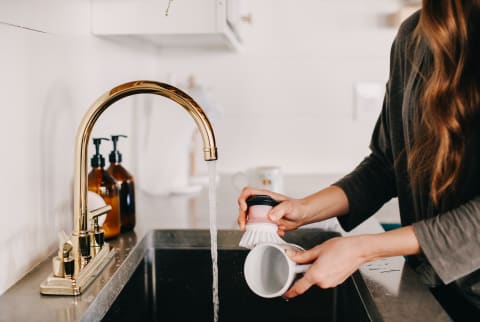Advertisement
Is Your Tap Water Safe? Here's How & Why To Test It


Poor and potentially dangerous water quality continues to plague communities nationwide, from Flint, Michigan, to California, where nearly 500 communities were just found to have unsafe drinking water containing trace amounts of cancer-causing chemicals.
Beyond prominent threats like lead and arsenic, there are thousands of other chemicals that can make their way into community water supplies. This has spurred the Centers for Disease Control to name contaminated drinking water "one of the most seminal public health challenges of the coming decades."
Why you should know what's in your home's tap water.
Lately, all eyes have been on PFAS—a type of commonly used industrial chemicals linked to an increased risk of cancer and hormone disruption that has made its way into up to a third of American drinking water supplies. The EPA recently began an investigation into the class of chemicals after communities across the country reported high levels of them in their water supplies. PFOA, one common type of PFAS, is thought to be especially prevalent.
"[PFOA] is becoming the chemical of concern. It degrades the environment and can destroy ecosystems. It is one of the worst contaminations I think we've ever seen in history because it's so widely used everywhere," Erin Brockovich (yes, that Erin Brockovich) tells mindbodygreen.
It's been 22 years since the California native won a multimillion-dollar lawsuit to remove hexavalent chromium from groundwater supplies in her home state (and 19 since Julia Roberts portrayed her poignant legal battle on the big screen), and Brockovich is still a vocal advocate for clean water. Because unfortunately, we still have a long, long way to go before it's a given for everyone.
In her current role as a consumer advocate, Brockovich hears from people nationwide who suspect that their drinking water is to blame for their mysterious health issues. Given the prevalence of substances like PFOA, her best advice is to ask more questions of your water and speak up if you don't like the answers.
"You don't have to be a doctor or scientist to care about your water and the health and welfare of your family. You're not going to find your solution if you don't know what the problem is—so don't be afraid to be in control of your own water systems," she says. "Don't think someone is going to come fix it for you."
How to get information on your water supply & a note on testing.
In order to properly treat and filter your water, you need to know what's in it in the first place. Color and odor changes are a dead giveaway that something might be off, but oftentimes chemicals in water will evade the senses. That's where tap water testing comes in.
If you get your water from a municipal supply (aka, not a well), you can head over to the EWG's Tap Water Database to find the most recent data on what's in your tap water, compared to state and national averages. However, some of these tests are outdated (the last available numbers in my area were from the summer of 2018), so take them with a grain of salt. For more up-to-date information, you can either reach out to your local municipality, which should offer monthly water quality reports, or take matters into your own hands.
Brockovich says that the at-home tests you can buy online aren't always accurate or comprehensive, so if you suspect that something is off or notice a significant change in your water, it might be worth shelling out the money for professional testing. This state-by-state EPA database1 lists all the laboratories that are certified to test potable water as well as air emissions. The EPA also shares advice2 on certain scenarios that should encourage you to get your water tested, such as drilling beginning nearby or sudden cloudiness in your tap.
If you want to get to the source of your water contamination, you can also consider getting involved in larger environmental initiatives. "For water safety advocacy, go to Waterkeeper Alliance, and they will help you take action to protect the waterways in your area and keep your tap water clean," says Gay Browne, an environmental health adviser and author of Living With a Green Heart.
Once you have a grasp on your water profile, you're ready to choose the right filter. Though on the pricier side, reverse-osmosis filters tend to remove a wider range of chemicals. Brockovich uses the AquaTru Countertop system in her home, and we've got you covered with some more expert-approved options.
Watch Next
Enjoy some of our favorite clips from classes
Enjoy some of our favorite clips from classes
What Is Meditation?
Mindfulness/Spirituality | Light Watkins
Box Breathing
Mindfulness/Spirituality | Gwen Dittmar
What Breathwork Can Address
Mindfulness/Spirituality | Gwen Dittmar
The 8 Limbs of Yoga - What is Asana?
Yoga | Caley Alyssa
Two Standing Postures to Open Up Tight Hips
Yoga | Caley Alyssa
How Plants Can Optimize Athletic Performance
Nutrition | Rich Roll
What to Eat Before a Workout
Nutrition | Rich Roll
How Ayurveda Helps Us Navigate Modern Life
Nutrition | Sahara Rose
Messages About Love & Relationships
Love & Relationships | Esther Perel
Love Languages
Love & Relationships | Esther Perel

















